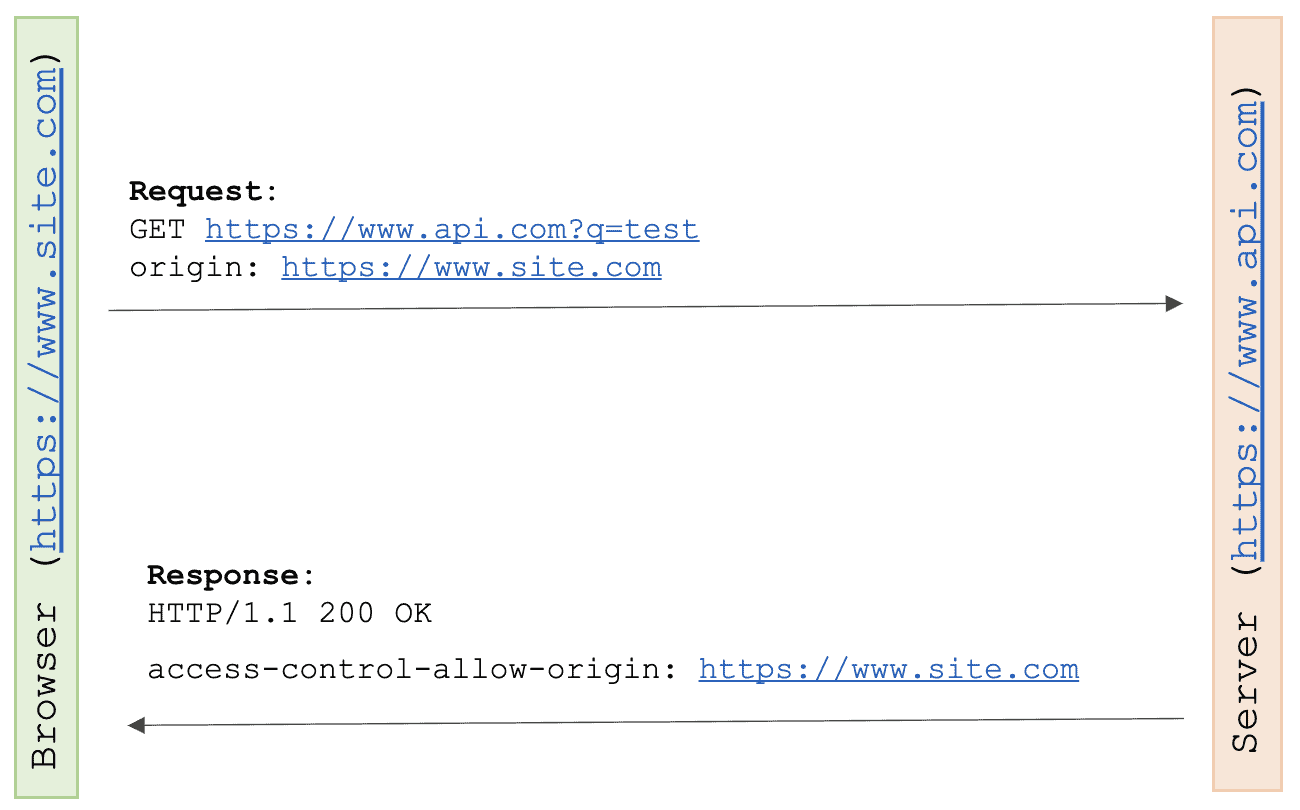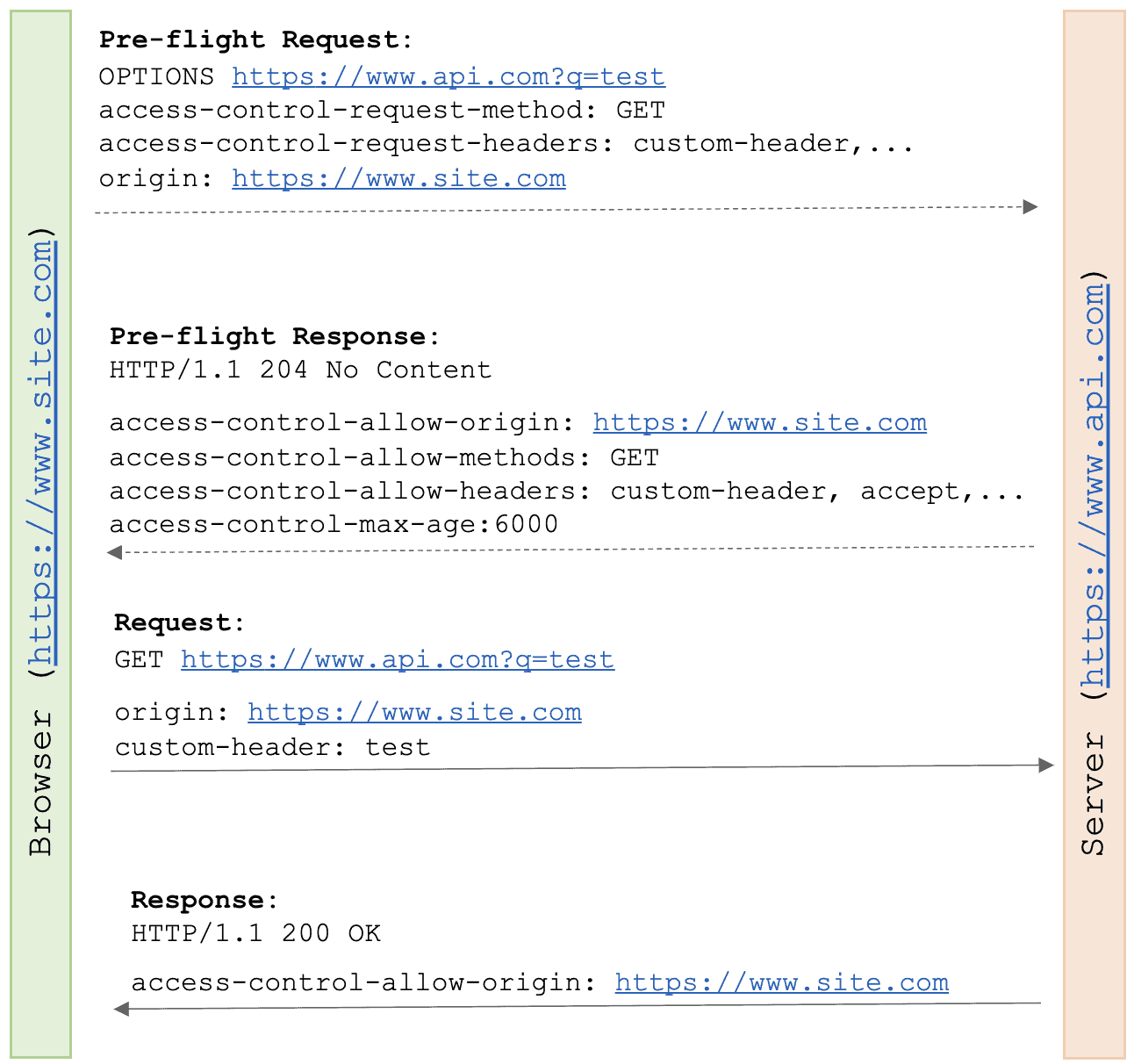1. Introduction
These days, the web pages we visit, frequently make requests to different servers in order to provide us with the data we see. This is called Cross-Origin Resource Sharing (CORS) and in this tutorial, we’re going to be discussing what it is, how the CORS policy is implemented in browsers, and why we have preflight requests.
2. What Is the Same Origin Policy?
Before we talk about CORS, let’s take a step back and introduce the Same Origin Policy (SOP); a default security measure in browsers that restricts how scripts from one origin interact with resources from another origin (cross-origin).
In the SOP context, we consider two URLs to be of the same origin if they have the same scheme, domain, and port number (if the URL includes a port). For example, https://www.baeldung.com and https://www.baeldung.com/about have the same origin, whereas https://www.baeldung.com and http://www.baeldung.com do not because of the difference in the scheme.
Browsers implementing the Same Origin Policy restrict website scripts served on one origin from making requests to another origin using methods such as XMLHttpRequest or the Fetch API.
3. What Is CORS?
To address the need for accessing third party APIs, the CORS policy determines how scripts served by one origin can request resources on another origin. The CORS policy defines specific HTTP headers that need to be included in the request/response interaction; allowing the server to communicate which origins it will allow requests from. The browser then enforces this by allowing or preventing scripts from accessing the response.
When it comes to cross-origin requests, there are three types that the browser deals with:
3.1. Simple Requests
A simple request is a request which fulfills the following:
- It is a GET, HEAD, or POST request
- Only sends automatic User-Agent headers or CORS Safelisted Headers such as Accept, Accept-Language, Content-Language, Content-Type
- The Content-Type header can only have the values application/x-www-form-urlencoded, multipart/form-data and text/plain
- Does not use a ReadableStream object
- XMLHttpRequest.upload does not have an event listener attached to it
Let’s take a look at the following simple CORS request initiated by this snippet of Javascript which runs on https://www.site.com:
const xhr = new XMLHttpRequest();
const url = 'https://www.api.com?q=test';
xhr.open('GET', url);
xhr.onreadystatechange = requestHandler;
xhr.send();
This will generate the following exchange between the browser and https://www.api.com:
- First, the browser sends the request with an origin header identifying the origin to the *https://*www.api.com server
- The server responds with the requested data and also includes an access-control-allow-origin header set to https://www.site.com which indicates to the browser that the server allows requests from this origin
- The browser will enforce this by allowing the requestHandler method to access the response data
We can summarise this exchange in the image below:

The access-control-allow-origin header is one of the main CORS headers a server can use to show what requests it will allow. The value of this header can either be a single origin to tell the browser to allow access to that specific origin, or it can be * which tells the browser to allow any origin.
If the server doesn’t respond with this header or if the header value is a domain that doesn’t match the origin of the request; then the browser will prevent the response from being passed back to the script. This could lead to console errors, for example, the image below shows the type of errors the Chrome browser generates if we try to make a GET request to http://www.google.com from our website:

3.2. Non-Simple Requests
Any request which is not a simple request is considered a non-simple or a preflighted request. The browser treats these kinds of requests a little differently. Before sending the actual request, the browser will send what we call a preflight request, to check with the server if it allows this type of request. A preflight request is an OPTIONS request which includes the following headers:
- origin – tells the server the origin where the request is coming from
- access-control-request-method – tells the server which HTTP method the request implements
- access-control-request-headers – tells the server which headers the request includes
In response to this, the server can decide if it will accept a request of this kind from this origin or not by responding with these headers:
- access-control-allow-origin – the origin that the server will allow
- access-control-allow-methods – a comma-separated list of methods that the server will allow
- access-control-allow-headers – a comma-separated list of headers that the server will allow
- access-control-max-age – tells the browser how long (in seconds) to cache the response to the preflight request
- A full list of possible CORS response headers are listed in the MDN Web Docs
Similar to simple requests, if the server doesn’t include any of the CORS headers, the browser will assume that this server doesn’t allow this request and won’t continue with the actual request.
Let’s see this in action by modifying our previous request slightly, we can make it non-simple if we add a custom header:
const xhr = new XMLHttpRequest();
const url = 'https://www.api.com?q=test';
xhr.open(‘GET', url);
xhr.setRequestHeader(‘custom-header', ’test')
xhr.onreadystatechange = requestHandler;
xhr.send();
The browser will identify this request as non-simple and will initiate a preflight request to the server to check if it allows it. Let’s take a look at how this interaction will look like if the https://www.api.com server allows this kind of request:

As we can see, the server responded with the correct headers and the browser continued to make the actual request. If the server had responded without the necessary headers, the browser would have prevented the request from going out.
Here we have an example in the browser where I am trying to access the Google Book API with a non-simple request that contains a custom header. We can see a slightly different error in the browser console because the API did not respond to the preflight request with the needed headers:

3.3. Credentialed Requests
Credentials can be cookies, authorization headers, or TLS client certificates. By default, the CORS policy doesn’t allow including credentials in a cross-origin request unless both the request includes a flag to include credentials and the server responds with the access-control-allow-credentials set to true.
To include credentials in our request, let’s update our XMLHttpRequest by setting the withCredentials property to true:
const xhr = new XMLHttpRequest();
const url = 'https://www.api.com?q=test';
xhr.open('GET', url);
xhr.withCredentials = true;
xhr.send();
If the server response doesn’t include the access-control-allow-credentials set to true and an access-control-allow-origin header that matches the same origin the request came from; the browser will block our request. An example of this is shown below where we try to make the same request to the Google Book API which doesn’t allow credentials:

4. What’s the Reasoning Behind Preflight Requests?
Since CORS was proposed after the SOP had been in place for some time, the idea of using preflight requests presented some advantages. With preflight requests, servers can examine requests before they’re executed and get a chance to indicate if they allow them.
If there is a side effect to a particular request which a server doesn’t allow from another origin; the preflight request helps to protect the unconsenting servers by checking first and blocking the request if the server responds with headers that indicate its refusal. In addition to this, servers may change what kind of requests and headers they allow as they’re developed. With preflight requests in place, browsers can check this and adjust accordingly.
Finally, CORS is backward compatible. Some older servers which may have been relying on SOP and do not handle CORS are still protected using this method because the browser will treat servers that send no CORS headers the same as servers that only allow requests from the same origin.
5. Conclusion
In this tutorial, we looked in some detail at cross-origin-resource policy and how browsers implement it. Browsers implementing CORS treat requests as three main types; simple requests, preflighted requests, and credentialed requests which can be simple or preflighted.